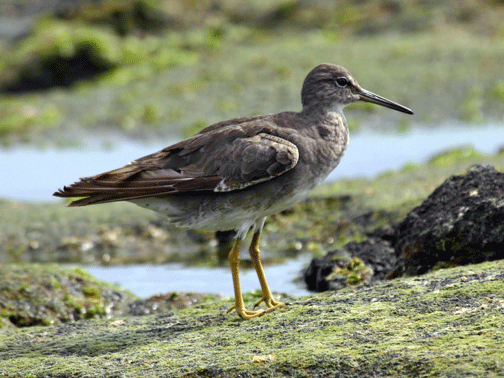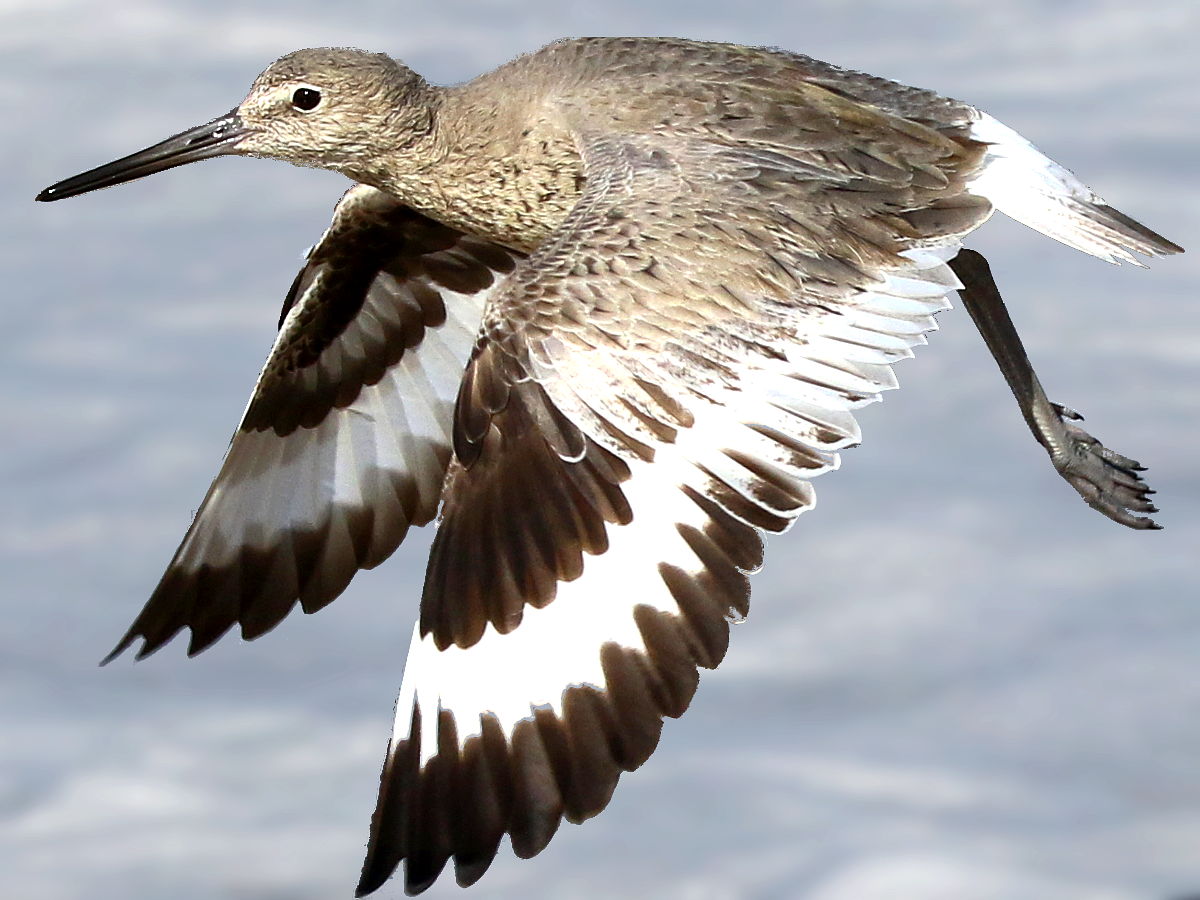|
Tringa
''Tringa'' is a genus of waders, containing the shanks and tattlers. The genus name ''Tringa'' is the Neo-Latin name given to the green sandpiper by the Italian naturalist Ulisse Aldrovandi in 1599. They are mainly freshwater birds, often with brightly coloured legs as reflected in the English names of six species, as well as the specific names of two of these and the green sandpiper. They are typically associated with northern hemisphere temperate regions for breeding. Some of this group—notably the green sandpiper—nest in trees, using the old nests of other birds, usually thrushes. The willet and the tattlers have been found to belong in ''Tringa''; these genus changes were formally adopted by the American Ornithologists' Union in 2006. The present genus in the old, more limited sense was even further subdivided into ''Tringa'' proper and '' Totanus'', either as subgenera or as full genera. The available DNA sequence data suggests however that neither of these ... [...More Info...] [...Related Items...] OR: [Wikipedia] [Google] [Baidu] |
Common Greenshank
The common greenshank (''Tringa nebularia'') is a wader in the large family Scolopacidae, the typical waders. The genus name ''Tringa'' is the Neo-Latin name given to the green sandpiper by Aldrovandus in 1599 based on Ancient Greek ''trungas'', a thrush-sized, white-rumped, tail-bobbing wading bird mentioned by Aristotle. The specific ''nebularia'' is from Latin ''nebula'' "mist". Like the Norwegian ''Skoddefoll'', this refers to the greenshank's damp marshy habitat. Relatives Its closest relative is the greater yellowlegs, which together with the spotted redshank form a close-knit group. Among them, these three species show all the basic leg and foot colours found in the shanks, demonstrating that this character is paraphyletic. They are also the largest shanks apart from the willet, which is altogether more robustly built. The greater yellowlegs and the common greenshank share a coarse, dark, and fairly crisp breast pattern as well as much black on the shoulders and ba ... [...More Info...] [...Related Items...] OR: [Wikipedia] [Google] [Baidu] |
Green Sandpiper
The green sandpiper (''Tringa ochropus'') is a small wader (shorebird) of the Old World. The green sandpiper represents an ancient lineage of the genus ''Tringa''; its only close living relative is the solitary sandpiper (''T. solitaria''). They both have brown wings with little light dots and a delicate but contrasting neck and chest pattern. In addition, both species nest in trees, unlike most other scolopacids. Given its basal position in ''Tringa'', it is fairly unsurprising that suspected cases of hybridisation between this species and the common sandpiper (''A. hypoleucos'') of the sister genus ''Actitis'' have been reported. Taxonomy The green sandpiper was formally described by the Swedish naturalist Carl Linnaeus in 1758 in the tenth edition of his ''Systema Naturae'' under the current binomial name ''Tringa ochropus''. The genus name ''Tringa'' is the Neo-Latin name given to the green sandpiper by Aldrovandus in 1599 based on Ancient Greek ''trungas'', a thru ... [...More Info...] [...Related Items...] OR: [Wikipedia] [Google] [Baidu] |
Common Redshank
The common redshank or simply redshank (''Tringa totanus'') is a Eurasian wader in the large family Scolopacidae. Taxonomy The common redshank was formally described by the Swedish naturalist Carl Linnaeus in 1758 in the tenth edition of his ''Systema Naturae'' under the binomial name ''Scolopax totanus''. It is now placed with twelve other species in the genus ''Tringa'' that Linnaeus had introduced in 1758. The genus name ''Tringa'' is the Neo-Latin name given to the green sandpiper by the Italian naturalist Ulisse Aldrovandi in 1603 based on Ancient Greek ''trungas'', a thrush-sized, white-rumped, tail-bobbing wading bird mentioned by Aristotle. The specific ''totanus'' is from , the Italian name for this bird. Six subspecies are recognised: * ''T. t. robusta'' ( Schiøler, 1919) – breeds in Iceland and the Faroe Islands; non-breeding around the British Isles and west Europe * ''T. t. totanus'' (Linnaeus, 1758) – breeds in west, north Europe to west Siberia; winter ... [...More Info...] [...Related Items...] OR: [Wikipedia] [Google] [Baidu] |
Willet
The willet (''Tringa semipalmata'') is a large shorebird in the family Scolopacidae. It is a relatively large and robust sandpiper and is the largest of the species called "shanks" in the genus ''Tringa''. Its closest relative is the lesser yellowlegs, a much smaller bird with a very different appearance apart from the fine, clear, and dense pattern of the neck, which both species show in breeding plumage. It breeds in North America and the West Indies and winters in southern North America, Central America, the West Indies and South America. Taxonomy The willet was Species description, formally described in 1789 by the German naturalist Johann Friedrich Gmelin in his revised and expanded edition of Carl Linnaeus's ''Systema Naturae''. He placed it in the genus ''Scolopax'' and coined the binomial nomenclature, binomial name ''Scolopax semipalmata''. Gmelin based his description on the "semipalmated snipe" from New York that had been described in 1785 by both the English ornitholo ... [...More Info...] [...Related Items...] OR: [Wikipedia] [Google] [Baidu] |
Tringa Solitaria
The solitary sandpiper (''Tringa solitaria'') is a small shorebird. The genus name ''Tringa'' is the Neo-Latin name given to the green sandpiper by Aldrovandus in 1599 based on Ancient Greek ''trungas'', a thrush-sized, white-rumped, tail-bobbing wading bird mentioned by Aristotle. The specific ''solitaria'' is Latin for "solitary" from ''solus'', "alone". Description This species measures long, with a wingspan up to and a body mass of .''CRC Handbook of Avian Body Masses'' by John B. Dunning Jr. (Editor). CRC Press (1992), . It is a dumpy wader with a dark green back, greyish head and breast and otherwise white underparts. It is obvious in flight, with wings dark above and below, and a dark rump and tail centre. The latter feature distinguishes it from the slightly larger and broader-winged, but otherwise very similar, green sandpiper (''T. ochropus'') of Europe and Asia, to which it is closely related. The latter species has a brilliant white rump. In flight, the solitary san ... [...More Info...] [...Related Items...] OR: [Wikipedia] [Google] [Baidu] |
Grey-tailed Tattler
The grey-tailed tattler (''Tringa brevipes'', formerly ''Heteroscelus brevipes''Banks, Richard C.; Cicero, Carla; Dunn, Jon L.; Kratter, Andrew W.; Rasmussen, Pamela C.; Remsen, J. V. Jr.; Rising, James D. & Stotz, Douglas F. (2006):Forty-seventh Supplement to the American Ornithologists' Union Check-list of North American Birds ''Auk (journal), Auk'' 123(3): 926–936. Digital Object Identifier, DOI: 10.1642/0004-8038(2006)123[926:FSTTAO]2.0.CO;2*Pereira, Sérgio Luiz & Baker, Alan J. (2005): Multiple Gene Evidence for Parallel Evolution and Retention of Ancestral Morphological States in the Shanks (Charadriiformes: Scolopacidae). ''Condor (journal), Condor'' 107(3): 514–526. Digital Object Identifier, DOI: 10.1650/0010-5422(2005)107[0514:MGEFPE]2.0.CO;2), also known as the Siberian tattler or Polynesian tattler, is a small shorebird in the genus ''Tringa''. The English name for the tattlers refers to their noisy call. The genus name ''Tringa'' is the Neo-Latin name given to the ... [...More Info...] [...Related Items...] OR: [Wikipedia] [Google] [Baidu] |
Tattler (bird)
The tattlers are the two very similar bird species in the shorebird genus ''Tringa''. They formerly had their own genus, ''Heteroscelus''. The old genus name means "different leg" in Greek, referring to the leg scales that differentiate the tattlers from their close relatives, the shanks. The species are: * Grey-tailed tattler, ''Tringa brevipes'' (formerly ''Heteroscelus brevipes'') * Wandering tattler, ''Tringa incana'' (formerly ''Heteroscelus incanus'') Tattlers resemble a common redshank (''T. totanus'') in shape and size, but not in color. Their upper parts, underwings, face and neck are greyish, and the belly and the weak supercilium are white, with some greyish streaking on the underside in breeding plumage. They have short yellowish legs and a bill with a pale base and dark tip.Hayman ''et al.'' (1986) Certain identification to species depends on details like the length of the nasal groove and scaling on the tarsus. Birds in breeding plumage can also (with some exp ... [...More Info...] [...Related Items...] OR: [Wikipedia] [Google] [Baidu] |
Totanus
''Totanus'' (Bechstein, 1803) is a generic name previously applied to various waders or shorebirds, now subsumed within ''Tringa''. Created by Johann Matthäus Bechstein, it derives from the species name for the common redshank, described by Carl Linnaeus in his landmark 1758 10th edition of ''Systema Naturae'' as ''Scolopax totanus'', from ''totano'', the Italian name for the bird.Higgins, P. J.; & Davies, S. J. J. F. (Eds). (1996). ''Handbook of Australian, New Zealand and Antarctic Birds. Volume 3: Snipe to Pigeons''. Oxford University Press: Melbourne. (page 131) Birds once placed in the genus include: * Common redshank (''Totanus totanus''), now ''Tringa totanus'' * Greater yellowlegs (''Totanus melanoleucus''), now ''Tringa melanoleuca'' * Lesser yellowlegs (''Totanus flavipes''), now ''Tringa flavipes'' * Willet The willet (''Tringa semipalmata'') is a large shorebird in the family Scolopacidae. It is a relatively large and robust sandpiper and is the largest of the ... [...More Info...] [...Related Items...] OR: [Wikipedia] [Google] [Baidu] |
10th Edition Of Systema Naturae
The 10th edition of ''Systema Naturae'' (Latin; the English title is ''A General System of Nature'') is a book written by Swedish naturalist Carl Linnaeus and published in two volumes in 1758 and 1759, which marks the starting point of zoological nomenclature. In it, Linnaeus introduced binomial nomenclature for animals, something he had already done for plants in his 1753 publication of ''Species Plantarum''. Starting point Before 1758, most biological catalogues had used polynomial names for the taxa included, including earlier editions of ''Systema Naturae''. The first work to consistently apply binomial nomenclature across the animal kingdom was the 10th edition of ''Systema Naturae''. The International Commission on Zoological Nomenclature therefore chose 1 January 1758 as the "starting point" for zoological nomenclature and asserted that the 10th edition of ''Systema Naturae'' was to be treated as if published on that date. Names published before that date are unavailable, ... [...More Info...] [...Related Items...] OR: [Wikipedia] [Google] [Baidu] |




